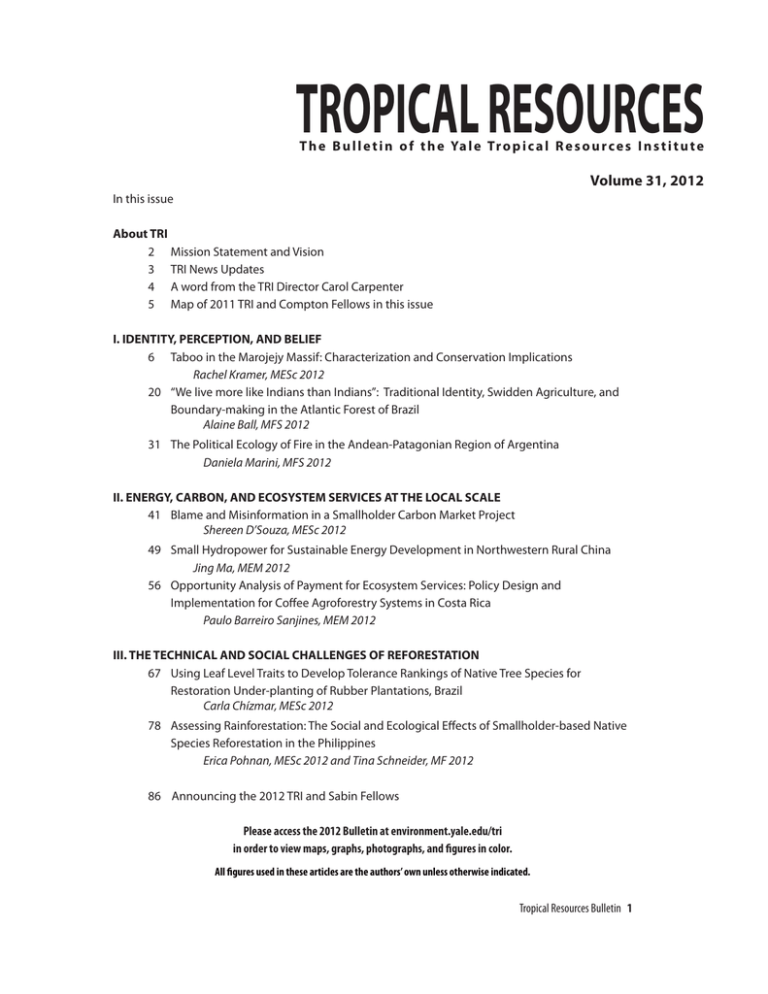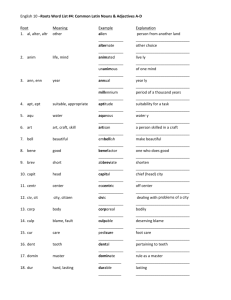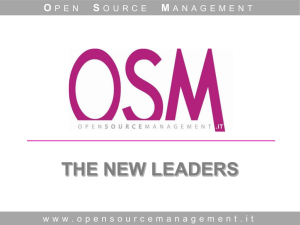TROPICAL RESOURCES Volume 31, 2012
advertisement

TROPICAL RESOURCES T h e B u l l e t i n o f t h e Ya l e Tr o p i c a l R e s o u r c e s I n s t i t u t e Volume 31, 2012 In this issue About TRI 2 Mission Statement and Vision 3 TRI News Updates 4 A word from the TRI Director Carol Carpenter 5 Map of 2011 TRI and Compton Fellows in this issue I. IDENTITY, PERCEPTION, AND BELIEF 6 Taboo in the Marojejy Massif: Characterization and Conservation Implications Rachel Kramer, MESc 2012 20 “We live more like Indians than Indians”: Traditional Identity, Swidden Agriculture, and Boundary-making in the Atlantic Forest of Brazil Alaine Ball, MFS 2012 31 The Political Ecology of Fire in the Andean-Patagonian Region of Argentina Daniela Marini, MFS 2012 II. ENERGY, CARBON, AND ECOSYSTEM SERVICES AT THE LOCAL SCALE 41 Blame and Misinformation in a Smallholder Carbon Market Project Shereen D’Souza, MESc 2012 49 Small Hydropower for Sustainable Energy Development in Northwestern Rural China Jing Ma, MEM 2012 56 Opportunity Analysis of Payment for Ecosystem Services: Policy Design and Implementation for Coffee Agroforestry Systems in Costa Rica Paulo Barreiro Sanjines, MEM 2012 III. THE TECHNICAL AND SOCIAL CHALLENGES OF REFORESTATION 67 Using Leaf Level Traits to Develop Tolerance Rankings of Native Tree Species for Restoration Under-planting of Rubber Plantations, Brazil Carla Chízmar, MESc 2012 78 Assessing Rainforestation: The Social and Ecological Effects of Smallholder-based Native Species Reforestation in the Philippines Erica Pohnan, MESc 2012 and Tina Schneider, MF 2012 86 Announcing the 2012 TRI and Sabin Fellows Please access the 2012 Bulletin at environment.yale.edu/tri in order to view maps, graphs, photographs, and figures in color. All figures used in these articles are the authors’ own unless otherwise indicated. Tropical Resources Bulletin 1 II. ENERGY, CARBON, AND ECOSYSTEM SERVICES AT THE LOCAL SCALE Blame and Misinformation in a Smallholder Carbon Market Project Shereen D’Souza, MESc 2011 ABSTRACT From Malthus’s economic theories, to colonial-era conservation initiatives, to the age of aid interventions, the rural poor in the Global South are commonly blamed for environmental degradation. The 1987 Bruntland Commission Report, for example, one of the founding documents of the concept and practice of modern sustainable development reads, “Those who are poor and hungry will often destroy their immediate environment in order to survive: They will cut down forests; their livestock will overgraze grasslands; they will overuse marginal land” (WCOEA 1987). As some of the political ecology literature reveals, narratives of blame, regardless of veracity, have been quite effective at furthering implicit economic and political goals of states and development institutions even when explicit goals related to poverty reduction or conservation are unmet. This paper traces the reproduction of blame narratives in the first-ever project to generate soil carbon credits in a smallholder context, focusing on responsibility for deforestation and misinformation on the role of trees in hydrologic cycles. Introduction From Malthus’s economic theories to colonial-era conservation initiatives, to the age of aid interventions, the rural poor in the Global South are commonly blamed for environmental degradation. And, as some of the political ecology literature reveals, discourses of blame, regardless of veracity, have been quite effective at furthering implicit economic and political goals of states and development institutions (see e.g. Ferguson 1994). In this paper, Shereen D’Souza graduated from Yale F&ES with an MESc degree. Her research focused on the intersections of international agricultural development and climate change. Prior to graduate school, Shereen worked on food justice and food policy issues in California. She holds a B.S. from the Georgetown School of Foreign Service. I review literature on blame and misinformation in colonial and post-colonial rural development and conservation interventions. Then, in presenting data on the Kenya Agricultural Carbon Project (KACP), I argue that smallholder responsibility for climate change because of deforestation is overemphasized by project staff, effectively obscuring the responsibility of other actors operating on a variety of temporal and geographic scales. I conclude the paper by offering reasons for why KACP reproduces a blame discourse and furthers misinformation about causes of and solutions to climate change. These factors include: pressure to meet high project enrollment goals, an unquestioned parroting of mainstream blame discourses, and limited access to information on the role of trees in hydrologic cycles. Acknowledging the need for further investigation, it remains to be Tropical Resources Bulletin 41 Shereen D’Souza seen whether KACP, in the long-term, will meet its explicit goals of reducing poverty, increasing food security and generating carbon credits given its use of blame narratives. villagers because of the multiple-use value the forest islands offered. As Lele (1991), Gray (2005), Duraiappah (1998), Broad (1994) and others note, the Literature The rural poor are to blame for environmental degradation In 1798, Thomas Malthus writes, “The labouring poor, to use a vulgar expression, seem always to live from hand to mouth. Their present wants employ their whole attention, and they seldom think of the future” (Malthus 1798). Gray (2005) argues that Malthus indirectly asserts the poverty-degradation link suggesting that the poor must, for example, deforest for firewood in order to feed themselves today, not considering the value of the tree for tomorrow. Moseley (2001) and Murphee (1993) argue that Malthus’s views are codified in contemporary economics literature as “time preference”: the poor have a higher rate of time preference than the wealthy who, because their present needs are adequately met, can consider the future and invest in protecting the environment. Blaikie (1985), discusses the reproduction of blame for environmental degradation in the colonial model of environmental governance. A precursor to Hardin’s Tragedy of the Commons (1968), the colonial model, Blaikie argues, asserts that soil erosion is caused by overpopulation of rural areas, as well as the ignorance and laziness of poor land users who are positioned, in the model, as the sole responsible parties for the degradation. Fairhead (1996) also identifies a colonial history of blaming poor, rural peoples for deforestation, even when deforestation does not exist. He argues that colonial administrators viewed the forest islands of Kissidougou, Guinea as remnants of a once-pristine forest progressively destroyed by locals, never considering the possibility and reality that the forest islands were created from savanna by the poor 42 Volume 31, 2012 Photograph 1. This KACP participant demonstrates her success with intercropping, one of the strategies promoted by KACP. Brundtland Commission report, released by the UN in 1987, popularized the concept of sustainable development, and further solidified the blaming of poor, rural peoples for degradation with, “Those who are poor and hungry will often destroy their immediate environment in order to survive: They will cut down forests; their livestock will overgraze grasslands; they will overuse marginal land” (WCED 1987). This narrative is also widely evident in the rhetoric of mainstream development institutions (see e.g. World Bank [1996] in Gray (2005:9); and Pinstrup-Andersen 1995). What does blame accomplish? There is plenty of evidence (e.g. Fairhead 1996; Gray 2005; Blaikie 1985; Thompson 1986) that the poverty-environmental deg- Blaming Smallholders in Kenya’s Carbon Market Figure 1. Map of study site. radation link is not always true and is always far more complicated than proponents of such theories suggest. Why, then, is it reproduced and reinvented so continuously? The literature points to economic and political motivations. Leach (1994) argues that, in the case of Kissidougou, erroneously blaming local peoples for deforestation, and actively and passively ignoring evidence to the contrary, has been largely driven by economic considerations: colonial administrators were concerned with protecting high-value wild rubber “threatened” by local resource users. In the 1980s and 90s, the authors argue, aid and development funding became increasingly dependent on “green conditionality”, i.e. the adoption of conservation measures (Leach 1994) predicated upon the need to conserve. Additionally, fines on locals for breaking laws related to timber extraction or wildlife use were an important revenue source for the forestry services for many years (Leach 1994). In a sense, the economic wellbeing of colonial, state, and local elite actors directly depended on the villagers of Kissidougou being guilty of deforestation. Blaikie (1985) suggests that blaming poor land users enabled the obfuscation of the real cause, or one of them, of soil erosion: the colonial appropriation of the most productive lands, with the resultant marginalization of local peoples onto less productive lands. Colonial administrations responded to the problem of erosion by developing a “helpful stance” involving extension services that, again, allowed for increased control of local environmental decision making by state authorities. Case Study – background and methods The Kenya Agricultural Carbon Project (KACP) provides fertile ground for examining the reproduction of discourses of blame as they relate to a global, shared environment: the atmosphere. Started in January 2009, KACP is a collaborative effort of Swedish NGO, ViAgroforestry, and the World Bank BioCarbon Fund. The project explicitly aims to reduce poverty while generating carbon credits by incentivizing Tropical Resources Bulletin 43 Shereen D’Souza poor smallholders farming highly degraded land in Nyanza and Western Provinces to adopt sustainable agricultural land management (SALM) techniques, such as cover cropping, mulching, adoption of high yield varieties, and incorporation of short-term and long-terms agroforestry trees on cropland. These practices are thought to improve yields while generating carbon credits by directly or indirectly sequestering carbon in soils and biomass both above and below ground (VCS 2010). In addition to promoting SALM technologies, the project also aims to train participants on establishing village savings and loan associations and cooperative enterprises, as well as on increasing market-oriented production. According to ViAgroforestry staff, trainings on these topics indirectly support carbon sequestration activities by improving livelihood options and reducing poverty, which in turn helps to attract and retain project participants. The project currently involves nearly 20,000 farmers, with the goal of eventually involving 60,000 smallholders farming on 45,000 hectares (Wekesa 2011). Participants are trained in groups by ViAgroforestry extension staff or by unpaid community facilitators who have been trained by extension staff. In general, all KACP staff come from the region where the project operates, with field extension staff often coming from the very villages in which the project operates. Most extension staff hold Certificates in Agronomy whereas administrative staff tend to hold college degrees. Methods Data were gathered in twelve villages near Kitale in Western Province and five villages near Kisumu in Nyanza Province through participant observation and interviews, as well as through reviewing project documents made available to me by ViAgroforestry staff. In total, I interviewed around 120 individuals from six main stakeholder groups: project staff, common-interest group leaders, project participants, non-participants, former participants 44 Volume 31, 2012 and the poorest members of the communities. Findings Smallholders blamed for climate change Interviews with project staff and observations at trainings for KACP participants revealed a dynamic in which staff blamed project participants for causing climate change. The following quote, from an extension staff person, comes from a training for KACP group leaders: “What do you think has caused the changes in the climate that you are seeing? Population pressure, cattle overstocking, deforestation and poor land management practices…The practices that you’ve done on your small parcels have caused climate change.”1 In this explanation of climate change, no attention was given to what other factors were also causing climate change, who was responsible for them, and the relative degree to which various factors and actors were responsible. In reaction to this explanation of causes of climate change, training attendees simply nodded or expressed agreement with the statements. It is obvious that KACP has a focus on generating carbon credits, but the actual mission of the project is “to integrate sustainable agricultural land management practices into smallholdings and make it [sic] an engine of economic growth and a means to reduce poverty” (World Bank 2009). Yet, when asked why smallholders should participate in KACP, most staff members stressed the need for smallholders to mitigate climate change equally to other projected project benefits, such as increased food security, income and adaptive capacity. Typical responses included “this project explains to farmers that climate change is with us and they must mitigate and adapt,”2 expressed by an extension staff person, and “farmers should participate in this project because they are emitting GHGs, but they will also get co-benefits like increased yields,” expressed by a project administrator.3 Blaming Smallholders in Kenya’s Carbon Market Misinformation on how climate change could be addressed Related to the blame narrative was misinformation presented to KACP participants about how they could reverse the effects of climate change. In addition to being told by KACP staff that they (the participants) had caused climate change by cutting down trees, most participants expressed the view that planting more trees, one of the main practices incentivized by the project, would “bring back the rains.” When asked how they were adapting to the decreased rainfall that they were witnessing, nearly all interviewees responded that planting more trees on their land was an adaptation strategy. While some suggested that the trees compensated for lack of rain by protecting soil moisture and improving rain penetration (by loosening soils), many felt that the simple act of planting trees would attract rain clouds. Again, the source of knowledge on the supposed treerain connection was ViAgroforestry. Analysis In considering why blame is reproduced in KACP, two possibilities must be considered: the narrative helps extension officers meet high enrollment goals, and the staff are simply parroting a discourse to which they are not immune. As for why misinformation related to the ability of planting trees to regularize rain patterns persists, we must consider whether staff truly believe that planting trees will “bring back the rains,” or whether they knowingly disseminate the misinformation because of the value associated with it. Enrollment goals In explaining climate change to a group of participants, the KACP extension officer, quoted above, says, “the practices that you’ve done on your small parcels have caused climate change.” Next, he says, “If you and your neighbors act, you’ll see changes.”4 Here, the assigning of blame for climate change is tied to wanting to give participants agency to change the situation, i.e. with guidance from ViAgroforestry, they can reverse the changes. Convincing farmers in KACP villages to act is critical in order for the project to survive. With the goal of eventually involving 60,000 farmers, in order to generate a meaningful amount of carbon credits, each extension officer has the responsibility to enroll 500 new farmers each year – no small task. Enrollment goals have already proved problematic to achieve, with extension officers, as of mid-2011 having only a 75% success rate. If an officer is unable to meet the goal of 500 new participants within a year, any unmet portion of the goal is rolled-over to the next year. With unemployment rates around 40% in Kenya (CIA 2011), pressure to keep their jobs is high for KACP staff. As a result, not only is it necessary to convince farmers that they have a responsibility to act and that their actions will produce a desirable result, extension staff must convince participants to also convince their neighbors that they too must act. Isolated action, the rhetoric goes, will not be enough to overcome climate change. As stated by the same extension officer quoted above, “communitywide participation is necessary for success.” Staff influenced by mainstream blame discourse Staff are not impervious to the global discourse that positions the rural poor as the cause of environmental degradation. The following quote on causes of climate change, from the Kenyan Minister of Agriculture, exemplifies why KACP staff might blame participants. “[We have contributed] in every way…At independence 14% of our land mass was forest. Today that has come down to 1% …That tells you human activity and agricultural settlement have significantly destroyed our natural resources especially forests. Therefore if we say that we have Tropical Resources Bulletin 45 Shereen D’Souza not contributed to climate change we will not be telling the truth” (Otieno 2010). Perhaps because of the benefits, such as funding for mitigation efforts, associated with being “guilty” of climate change, the Kenyan minister pays no attention to the amount of deforestation carried out during British rule, what portion of the post-independence deforestation was caused by non-agricultural activity, what types of agricultural development have caused deforestation, and which processes might have indirectly caused deforestation by forcing poor smallholders onto forested lands. Interestingly, the Kenyan government official, instead of pointing a finger at the industrialized world for their historical responsibility for GHG emissions, points a finger at his own people. Here, as Leach (1994) might argue, showcasing the need to change environmentally destructive behaviors at home is more likely to draw international aid and development funding than convincing the developed world of its climate debt or even attempting to articulate a more nuanced argument about responsibility for climate change. Misinformation related to tree planting In considering how to address the pervasive misinformation on the role of trees in rain cycles, we must consider whether the misinformation is knowingly or unknowingly perpetuated. Staff may knowingly perpetuate the misinformation because more trees planted means more carbon credits generated. Or, because of the likelihood that smallholders will cut down the trees once they reach a point of maximum financial profitability, if not before, potentially undermining the viability of the carbon credits generated, staff may knowingly lie about the value of the trees in order to avoid this issue. At the same time, it is quite possible that the myth of trees is disseminated because staff understanding of the relationship between trees and rain is incomplete, possibly because of issues of scale and temporality. While for- Photograph 2. Members of a women farmers group near Kisumu participating in KACP. 46 Volume 31, 2012 Blaming Smallholders in Kenya’s Carbon Market ested areas do tend to experience higher rates of rainfall than non-forested areas because of evapo-transpiration from tree leaves, the size of the farm that KACP targets makes it virtually impossible for tree-planting efforts to markedly impact rainfall patterns. The typical KACP farmer owns less than one hectare on which (s)he plants subsistence crops and maintains a homestead, in addition to possibly planting trees. Reasons for this potential disconnect warrant further attention. Conclusion Drawing on a long history of blaming the rural poor for environmental degradation, the Kenya Agricultural Carbon Project blames smallholders for causing climate change through deforestation. Reasons for why this narrative is reproduced likely relate to enrollment-goal pressures or because the project exists within a mainstream development complex founded on unquestioned blame as a justification for intervention. In this paper, I also question why misinformation on the ability of on-farm tree-planting to reverse climate impacts is disseminated, and in response, I consider whether the misinformation is reproduced for ulterior motives or whether project staff are confused about the scale at which trees operate within a hydrologic cycle. These possibilities warrant further attention. Regardless of the reasons why KACP reproduces blame and misinformation, it is clear that the project, in terms of equity, could be improved if these issues were addressed. The analysis presented here focuses on a single case study, but the phenomenon of linking poor, rural populations to the carbon markets or mitigation projects generally, through land use, land use change, and forestry practices, is growing rapidly. Any such project that reinforces a blame discourse would be problematic, especially because the environment supposedly being degraded is supralocal. According to the discourse, while it might be bad for the poor to degrade their own environment, if they are degrading our shared environment, intervention would be unquestionably justified. Additionally, any project that spreads incorrect information might run the risk of project failure. If, for example, it becomes clear that the persistent efforts of KACP participants to reverse the impacts of climate change through planting trees does not produce the expected effect, widespread project abandonment could occur. Whether or not these problematic aspects of KACP could be rectified remains to be seen. Endnotes 1. It should be noted that project rhetoric paid no attention to the possibility that the “changes in the climate” were not in fact related to global climate change but rather to climate variability, often multi-year in length, common throughout Africa. For more on this, see Hulme (2005) and Balling (2005). 2. Interview with “extension staff l”. July 20, 2011. 3. Interview with “administrative staff g”. August 3, 2011. 4. Interview with “extension staff d”, July 4, 2011. ACKNOWLEDGMENTS The research upon which this article is based was made possible by the generous support of the Tropical Resources Institute, Carpenter Sperry Fund, Program in Agrarian Studies and the Jubitz Family Fund. I am grateful for the advice and support offered by Professor Michael Dove and Professor Amity Doolittle. Finally, I would like to acknowledge and thank all the farmers and KACP staff members who participated in the research. REFERENCES Balling, Jr., R. (2005). Interactions of Desertification and Climate in Africa, in Climate Change and Africa. Ed. Pak Sum Low. Cambridge University Press, New York. Blaikie, P. (1985). The Political Economy of Soil Erosion in Developing Countries. Longman Inc, New York. Tropical Resources Bulletin 47 Shereen D’Souza Broad, R. (1994). The Poor and the Environment: Friends or Foes?. World Development 22(6): 811-822. CIA(Central Intelligence Agency). World Factbook: Economy: Kenya. CIA. https://www.cia.gov/ library/publications/the-world-factbook/geos/ ke.html (December 16, 2011). Duraiappah, A. K. (1998). Poverty and Environmental Degradation: A Review and Analysis of the Nexus. World Development 26(12): 21692179. Fairhead, J. and Leach, M. (1996). Misreading the African Landscape: Society and Ecology in a Forest Savannah Mosaic. Cambridge University Press, Cambridge. Ferguson, J. (1994). The Anti-Politics Machine: Development, Depoliticization, and Bureaucratic Power in Lesotho. University of Minnesota Press, Minneapolis. Gray, L. C. and Moseley, W. (2005). A Geographical Perspective on Poverty–environment Interactions. Geographical Journal 171(1): 9-23. Hardin, G. (1968). The tragedy of the commons. Science 162: 1243-1248 Hulme, M. Doherty, R., Ngara, T., et al. (2005). Global Warming and African Climate Change, in Climate Change and Africa (2005). Ed. Pak Sum Low. Cambridge University Press, New York. Leach, M., and Fairhead, J. (1994). Natural Resource Management: The Reproduction and Use of Environmental Misinformation in Guinea’s Forest-savanna Transition Zone. IDS Bulletin 25(2): 81-87. Lele, S. M. (1991). Sustainable Development: A Critical Review. World Development 19(6): 607-621. Malthus, T. R. (1798). An Essay on the Principle of Population, W.Pickering, London, 1986. Moseley, W. G. (2001). African Evidence on the Relation of Poverty, Time Preference and the Environment. Ecological Economics 38(3): 317-326. Murphree, M.W. (1993). Communal Land Wildlife Resources and Rural District Council 48 Volume 31, 2012 Revenues. Centre for Applied Social Sciences (CASS), University of Zimbabwe, Harare. Otieno, S., Pauker, E. and Maina, P. (2010). Kenya Talks Climate. BBC World Services Trust. http://africatalksclimate.com/research/kenyatalks-climate (December 16, 2011). Pinstrup-Andersen, P., and Pandya-Lorch, R. (1995). Poverty, Food Security and the Environment. International Food Policy Research Institute: Washington, DC. http://www.ifpri. org/sites/default/files/publications/vb29.pdf (March 8, 2012). Thompson, M., Warburton, M., and Hatley. T. (1986). Uncertainty on a Himalayan Scale: An Institutional Theory of Environmental Perception and a Strategic Framework for the Sustainable Development of the Himalaya. Ethnographica, London. VCS (Voluntary Carbon Standard). (2010). Western Kenya Smallholder Agriculture Carbon Finance Project: Project Description Draft. Unpublished document. WCED (World Commission On Environment And Development). (1987). Our Common Future. (G. H. Brundtland, Ed.) Oxford paperbacks (Vol. Report of, p. 400). Oxford University Press. Retrieved from http://www.un-documents.net/wced-ocf.htm Wekesa, A. (2011). Keynote on KACP. Unpublished Powerpoint Presentation. World Bank. (2009). Carbon Finance Document for Land Use, Land-Use Change and Forestry (LULUCF) Projects. Unpublished document.





